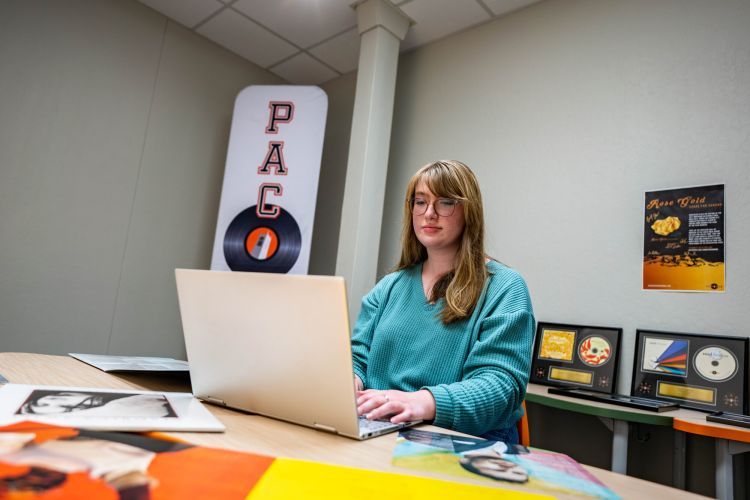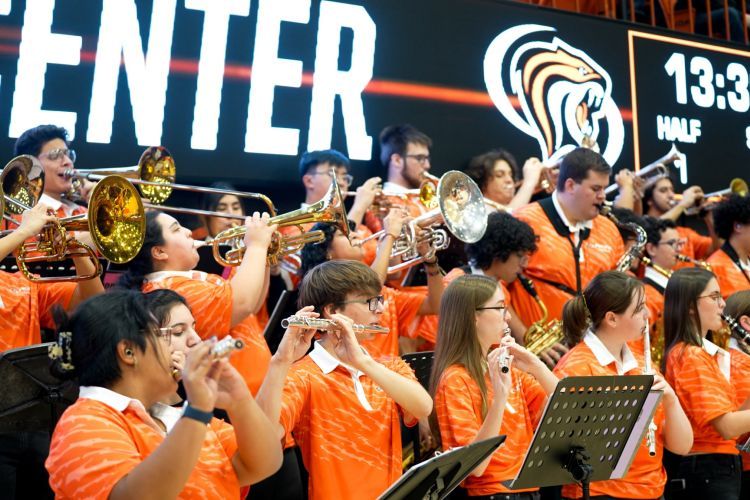Breadcrumb
Pandemic challenges push students to become better musicians

Conservatory brass students perform at inaugural Pacific Octubafest.
After a long year of virtual performances, often with only a camera as an audience, the return of live music during the fall semester was profound for Pacific Conservatory of Music students and faculty—but it wasn’t easy. The pandemic forced creative, multi-layered approaches to ensure safety while spotlighting performances.
Using specialized masks, air purifiers and other measures, the Conservatory pushed forward with a full schedule of concerts, allowing students to come together in person for the first time since the start of the pandemic, said Nicolasa Kuster, associate professor, program director for woodwinds and associate dean of academic affairs.
“That's the beauty of music,” said Filo Ebid ’23, a vocal performance major. “It's not just playing beautifully or sounding amazing. It's being able to communicate, and to connect with somebody, and connect with the ensemble.”
Becoming better musicians
Through the challenges, some students are finding they’re becoming better musicians.
“I'm noticing with myself and with my peers, the growth that has come from being able to step up and give an equally professional and excellent performance (virtually or in person) has been very noticeable,” said Ebid, “We’ve become professionals already before leaving Pacific.”
Wearing masks presented one of the biggest challenges.
Flutists used masks resembling a bag with a slot for the flute to go in, allowing air to move across the instrument while still being covered.
Vocalists turned to special masks made of cloth, which are positioned away from the mouth to allow for resonance and freedom of movement while singing. Singers had to learn how to compensate for facial expressions hidden by masks, a crucial part of performances such as the Opera Follies.
“You have to be that much more committed to your body movement, your eyes, your upper face, and to still tell a story. And there's a lot to be learned from that,” said Jonathan Latta, associate professor and ensemble administrator.
The Conservatory used subtle microphone amplification to help during concerts, but students also had to push themselves vocally.
“For a career in opera you have to be able to fill an opera house that seats 2,000-3,000 people … With the mask it has forced us to sing out and fill a room regardless of what barrier is in front of us,” said Ebid. Many students brought back new skills acquired from playing remotely.
“They had to learn how to use microphones and digital audio workspace stations (while remote),” said Kuster. “They had to learn about acoustics. They had to adjust their bedrooms to be a room they could use as an acoustical space.”
Through all the videos they recorded during the pandemic, they learned how to communicate with an audience through a screen, something Ebid says is “extremely difficult to do.”
There are subtle changes Kuster is noticing this semester. A student who couldn’t make a lesson sent her a recording of the material without being asked, something she doesn’t think would have happened prior to the pandemic.
“I think the adaptability and resilience has been one of those silver linings (of the pandemic),” Kuster said.
Taking nothing for granted
The pandemic has also taught students how much they value playing music together.
“Everyone tried to be in all the ensembles and do all the groups they could to play music with people again,” said Charlotte Han ’23, a violin performance and music management double major.
Pacific’s orchestra concert held in September was the first time Phoenix Farris ’23 was able to perform in front of an audience in 18 months.
“I was so emotional. I was nearly crying during the concert because I was so happy to be back on stage making music,” said Farris, a flute performance and music history double major.
Four recently graduated students came back to campus to perform solos during that concert (Diego Bustamante, piano; Abigail Hernandez, soprano; Tristen Collinsworth, bassoon; and Monica Mendoza, flute). They had earned the opportunity in the Conservatory Concerto Competition the year before but never got to perform due to the pandemic.
Audiences have been just as eager for the return, with modifications made to keep them safe.
Seats were spaced out for the Opera Follies while the Prism Concert was moved to a venue that provided more space.
“I think there's a hunger and appetite, and (audiences) know that we're doing things the right way, so they feel safe and comfortable to come out and enjoy our concerts,” said Latta.
“It's really nice to feel that community support and the vibrancy of so many students being together,” said Han, reflecting on the return of Mahler at Pacific, a concert that puts select high school musicians alongside Pacific’s Symphony Orchestra.
Students and faculty look forward to more live music during spring semester, while keeping a close eye on COVID-19.
“I think people took it for granted, the power of making music together,” said Kuster. “And no one is anymore.”
Take in an upcoming concert
Henry and Carol Zeiter Piano Competition: Jan. 15, 8 a.m. – 6:30 p.m. at Recital Hall, $10
Conservatory Honors Recital: Jan. 31, 7:30 – 9:30 p.m. at Recital Hall
Resident Artist Recital: featuring Patricia Shands, clarinet; Igor Veligan, violin; and Natsuki Fukasawa, piano: February 4 from 7:30 – 9:30 p.m. (free for students, others $5-10)





